English FormC ENetwork v4.0 Chapter 9
语言学09--Chapter 9 Language and Literature.ppt

Stylistics also attempts to establish principles capable of explaining the particular choices made by individuals and social groups in their use of language, such as socialisation, the production and reception of meaning, critical discourse analysis and literary criticism.
7
In addition, stylistics is a distinctive term that may be used to determine the connections between the form and effects within a particular variety of language.
14
In the wider sense of stylistics, text linguistics, and literary studies, it is a
translation of the Czech aktualisace
(actualization), a term common with the Prague Structuralists.
12
The red-haired woman, smiling, waving to the disappearing shore. She left the maharajah; she left innumerable other lights o’ passing love in towns and cities and theatres and railway stations all over the world. But Melchior she did not leave.
综合教程第四册Unit 9 Text I 词汇学习
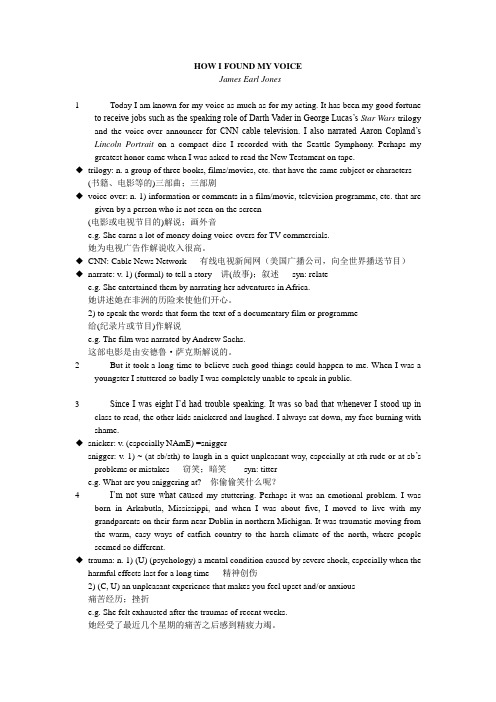
HOW I FOUND MY VOICEJames Earl Jones1 Today I am known for my voice as much as for my acting. It has been my good fortuneto receive jobs such as the speaking role of Darth Vader in George Lucas’s Star Wars trilogy and the voice-over announcer for CNN cable television. I also narrated Aaron Copland’s Lincoln Portrait on a compact disc I recorded with the Seattle Symphony. Perhaps my greatest honor came when I was asked to read the New Testament on tape.◆trilogy: n. a group of three books, films/movies, etc. that have the same subject or characters(书籍、电影等的)三部曲;三部剧◆voice-over: n. 1) information or comments in a film/movie, television programme, etc. that aregiven by a person who is not seen on the screen(电影或电视节目的)解说;画外音e.g. She earns a lot of money doing voice-overs for TV commercials.她为电视广告作解说收入很高。
◆CNN: Cable News Network 有线电视新闻网(美国广播公司,向全世界播送节目)◆narrate: v. 1) (formal) to tell a story 讲(故事);叙述syn: relatee.g. She entertained them by narrating her adventures in Africa.她讲述她在非洲的历险来使他们开心。
牛津译林版英语9B 九年级下册Unit4RevisionI课件
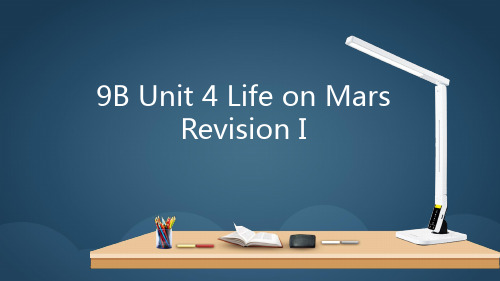
Barney: In my opinion , there is no life on Mars. You know, the environment there is not suitable for life at all. How can people __l_iv_e__o_n_M__a_r_s____ if there is no oxygen?
travel into space dried food sleeping bag
(all) over again in the form of
compare to/ with at a/ the speed of by the year 2100
随着技术的发展 人口的快速增长 感到不舒服 大量旅客 飘离到太空中 (使)连接; 联接 因为低重力 住在火星上
wouldn't have to go to school. An interplanetary network would allow them to study at online
schools.
完成句子 1. 欢迎以钱的形式资助。
_H_e_l_p_i_n_t_h_e__fo_r_m__o_f_m__o_n_e_y____ will be welcome. 2. 据说大批的游客在五一假期去了西藏。
Teaching aims: 1. To review words and important phrases on the topic ; 2. To review grammar in this unit; 3. To do some exercises.
Key WLeabharlann rds1. 行星 n.planet
_C_o_m__p_a_r_e_d_w__it_h_t_h_e__li_fe__o_n_t_h_e_E_a_r_t_h___, life on Mars would be better in some ways. 5. 由于人口急剧增长,我们的城市变得越发拥挤,污染日益严重。
新编英语教程第三版BOOK2 Unit 9

Betty
The crows are born with the gift of manufacturing
Unit 9
extraction cages
Bear bile extraction
Language Points
Unit 9
outrageous adj.: very shocking and extremely unfair or offensive 骇人的,极不公正的,蛮横的 prohibit v. / n. forbidden by means of law, rule, or official agreement prohibit / ban / forbid sb. from doing forbid: 通俗用语,指直接地、面对面吩咐不许他人采取某种行动。 prohibit:正式用词,多指通过法律手段或制订规则加以禁止。 ban: 语气最强,指权威机关明文取消或禁止严重危害公众利益的事或
我们最近15年一直参加反对捕鲸的运动。 We have campaigned against whaling for the last 15 years.
Language Points
Unit 9
bear baiting — a form of entertainment which involves setting dogs to attack a captive bear 纵狗逗熊(旧时一种娱乐形式) bullfighting —斗牛
B: Oh, it must be Zhang.
Unit 9
Practice II
1. A: What’s the name of the person (whom) you sat next to last night?
新目标综合教程3unit1课后练习答案

populate urge
Adjective _m_i_g_ra_n_t_ migratory
persistent
populous _p_o_p_u_la_te_d__
_u_r_g_e_n_t
Language in Use Word family (suffixes)
4) Sentence correction Find the wrongly used forms in the sentences and correct them.
amusing, disturbing, verbs overwhelming,
inspiring
Language in Use Word family (suffixes)
1) Knowledge of suffixes —— Adjective suffixes
Adjective Suffixes
精选可编辑ppt
1
1 Word family: suffixes
2 "Verb + at" Construction
3 "Verb + with" Construction
4
Translation of expressions vague in meaning
5
Use of connectives in translation from Chinese to English
sharp
Language in Use Word family (suffixes)
3) Exercise 4A Finish the following exercises on word formation and word use in context.
通信与电子信息工程专业英语
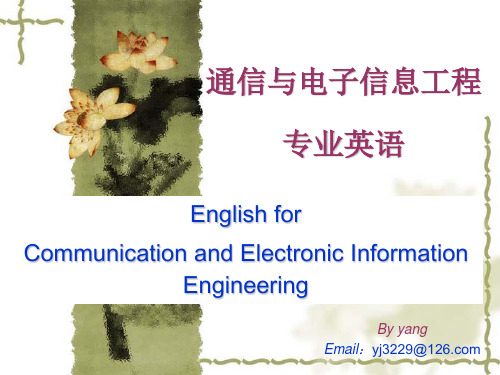
analog-- digital :模拟的--数字的 continuous-- discrete: 连续的--离散的
0.1 科技英语的特点 features
0.1.2 词汇 Vocabularies or words
转意词汇
Transfered words
有些单词的通用含义很接近,但它们的专业含义却完全不 同,如:
field
bus network rectifier regulator monitor
田野, 场地, 领域
公共汽车 网、网状组织 修正者 调整者 班长
(电、磁)场
总线 网络 整流器 稳压器 显示器、监视器
0.1 科技英语的特点 features
0.1.2 词汇 Vocabularies or words
依据谓语动词把复合句分解成一组简单句。 Insulation 绝缘,insulated ,insulating 依据关键词简化词组。 dielectric constant 介电常数 e.g. The ratio of the capacitance with some material other than air between the plates, to the capacitance of the same capacitor with air insulation, is called the dielectric constant of that particular material. ratio is called constant
Interactive-network → internet
互联网、因特网
transmitter-receiver → transceiver 收发器
计算机网络(第四版)英文原版1.9 Summary

A factor in the delay of a store-and-forward packet-switching system is how long it takes to store and forward a packet through a switch. If switching time is 10 μsec, is this likely to be a major factor in the response of a client-server system where the client is in New York and the server is in California? Assume the propagation speed in copper and fiber to be 2/3 the speed of light in vacuum.
Well-known networks include the Internet, ATM networks, Ethernet, and the IEEE 802.11 wireless LAN. The Internet evolved from the ARPANET, to which other networks were added to form an internetwork. The present Internet is actually a collection of many thousands of networks, rather than a single network. What characterizes it is the use of the TCP/IP protocol stack throughout. ATM is widely used inside the telephone system for long-haul data traffic. Ethernet is the most popular LAN and is present in most large companies and universities. Finally, wireless LANs at surprisingly high speeds (up to 54 Mbps) are beginning to be widely deployed.
Unit3TheInternet词汇公开课课件-高中英语人教版

快速识记• cash /kæʃ/ n.[U] 现金;现款
• update /ʌpˈdeɪt/ vt. 更新,向……提供最新信息 n. [U] 更新,最新消息
• database/ˈdeɪtəbeɪs/n. 数据库,资料库 • software/ˈsɒftweə(r)/ n.[U] 软件
• network/ˈnetˌwɜːk/ n.[U] (互联)网络;网状系统;人际网 vt. 将……连接成网络;联播 vi. 建立工作关系
vt. 更新,向……提供最新信息 n. [U] 更新,最新消息
database /ˈdeɪtəbeɪs/
n. 数据库,资料库
software /ˈsɒftweə(r)/
n.[U] 软件
network /ˈnetˌwɜːk/
n.[U] 网络
Observe and think about how these words are built or formed.
2.The only access to the f有ar…mh…ou的se机is会a;cro可ss以th进e入fi/e接ld近s.
去那农舍的 唯一通道 是穿过田野。
vt. to open a computer file in order to get or add information访问, 存取;to reach, enter or use sth到达;进入;使用
当你方便的时候 I,t欢(形迎主来) is访c。onvenient for sb to do sth
做某事对某人而言是方便的
convenient(adj.)
--[OPP.]: inconvenient --[n.] convenience
.
4.People still found coins inconvenient to carry, when
《专业英语》课件(1)-Electrical_Network

charge increment; time increment 电荷增量;时间增量 in proportion to; proportional control 与…成比例;比例控制 resistance;inductance;capacitance 电阻;电感;电容 proportionality constant 比例常数
Translation Technique
有关专业英语的 翻译、词汇和理解
翻译大师林语堂说:翻译的艺术所 依赖的,第一是译者对于原文文字及内 容上透彻的了解;第二是译者有相当的 国文程度,能写清顺畅通的中文;第三 是译事上的训练,译者对于翻译标准及 技术问题有正当的见解。此三者之外, 绝对没有什么纪律可为译者的规范,像 英文文法之于英文作文。
Electrical and Electronic Engineering Basics
P1U1 Electrical Networks
Dictation-1(5 minutes)
From Chinese to English
From English to Chinese
闭环控制 反馈元件 过电压 带宽 总线
electricity: (n.)noun form 电 electrician: (n.) expert in setting up, repairing and operating electrical apparatus 电气技师,电气技术员 electron: (n.) subatomic particle of matter 电子, having a negative electric charge
Questions
What elements does an electrical
E时代大学英语——综合训练1 期中测试

e.g. high → height (高度) 34 __w_i_ll_in_g___ → willingness(愿意 )
29 __e_f_f_e_ct___ → effective(有效的 )
35 __p_u_n_c_tu_a__l → punctuality(准时 )
Section E
Directions: Choose the suitable words and complete the sentences below. Change the form where necessary.
30 _e_l_e_m__e_n_t _ → elementary(基础的 )
e.g. like → dislike(不喜欢) 26 a_p_p_r_o_p_r_ia→te inappropriate(不合适的 )
words changing from an adjective into an adverb: e.g. quick → quickly(快地)
Section D
Directions: Write the primary forms of the following words from the text and then give the Chinese meanings for them.
word opposite to the original word:
期中测试
Part.01
Vocabulary and Structure
Section A
Directions: Complete the following sentences with the proper form of the words given in brackets. 1 We all argued about it for hours and eventually arrived at a (decide) ____d_e_c_is_i_o_n___. 2 He resigned from the company in order to take a more (challenge) ___c_h_a_ll_e_n_g_in_g__ job. 3 The best advice is to eat (regular) ____re_g_u_l_a_r_ly___ and get plenty of sleep. 4 Her (perform) __p__e_rf_o_r_m_a_n_c_e_ impressed the audience. 5 The audience are listening (attentive) ___a_tt_e_n_t_iv_e_l_y__. 6 Wear (comfort) __c_o_m__fo__rt_a_b_l_y_ and loosely in your exercise class. 7 I’m trying to train my boyfriend to do the (occasion) ___o_c_c_a_si_o_n_a_l__ bit of housework. 8 It’s time to (celebration) ___c_e_le_b_r_a_t_e___. 9 He remains confident and (seeming) __s_e_e_m__in_g_l_y___ untroubled by his recent problems. 10 Exercise can make a big (differ) ____d_if_fe_r_e_n_c_e__ to your state of health.
2024版English关于互联网

目录•The Internet and Its Impact •Types of Internet Services •Benefits of the Internet •Challenges Posed by the Internet •Future Trends in Internet Technology•Conclusion: The Internet in Our Lives01The Internet and Its ImpactIntroduction to the InternetThe internet is a global network of interconnected computers thatenables information sharing and communication.It was developed in the 1960s as a way for researchers to shareinformation and has since evolved into a platform for globalcommunication and commerce.The internet consists of millions of websites, social mediaplatforms, and other online services that can be accessed througha web browser or mobile app.Global Reach and ConnectivityImpact on Communication010203Impact on Business and EconomyThe internet has transformed the way businesses operate, with many companies now relyingon online sales and marketing strategies to reach customers.It has enabled new business models, such as e-commerce and subscription-based services, toemerge and thrive.The internet has also created new opportunities for entrepreneurs and small businesses tocompete with larger corporations on a global scale.02Types of Internet ServicesWorld Wide WebEmail and Instant MessagingSocial Media and NetworkingOnline shopping refers to the process of buying goods or services over the Internet.E-commerce (electroniccommerce) is the broaderterm that encompassesall commercialtransactions conductedelectronically.Online shopping hasbecome increasinglypopular due to itsconvenience, accessibility,and the wide range ofproducts and servicesavailable.Major e-commerceplatforms includeAmazon, eBay, andAlibaba, while manybrick-and-mortar retailersalso offer onlineshopping options.Online Shopping and E-commerce03Benefits of the InternetAccess to Information and KnowledgeUnlimited Resources01Online Learning02Digital Libraries03Online ShoppingThe internet enables individuals to shop online for a wide range of products and services, often with faster and more convenient delivery options.Remote WorkThe internet facilitates remotework, allowing employees to workfrom home or other locations,which can improve work-lifebalance and reduce commutingtime and costs.Automation andProductivityThe internet enables the use ofvarious tools and applicationsthat automate tasks and improveproductivity in both personal andprofessional settings.Convenience and EfficiencyStreaming ServicesThe internet provides access to a wide range of streaming services for music, movies, TV shows, and other forms of entertainment.Online gaming platformsallow individuals to playgames with others fromaround the world, providingan engaging and socialform of entertainment.Social media platformsenable individuals toconnect with friends, family,and interests, shareexperiences, and discovernew content.Online Gaming Social MediaEntertainment and LeisureEnhanced Communication and CollaborationEmail and MessagingVideo ConferencingCloud Computing04Challenges Posed by the Internet01 02 03Malware and Viruses Phishing and Scams Hacking and CyberattacksCyber Security ThreatsData Collection Social MediaOversharing Surveillance andSpyingOnline Privacy ConcernsDigital DivideAccess InequalityMany people, especially in rural or economically disadvantaged areas, still donot have access to reliable and affordable internet services.Skills GapEven among those who have internet access, there can be a significant gap indigital literacy skills, limiting their ability to fully benefit from online resources.Digital ExclusionCertain groups, such as older adults or individuals with disabilities, may faceadditional barriers to accessing and using the internet effectively.Internet Addiction and Health Risks05Future Trends in Internet TechnologyConnecting Physical Devices Enabling SmartEnvironmentsDriving IndustrialAutomationThe Internet of Things (IoT)Artificial Intelligence (AI) and Machine Learning Transforming Data AnalysisEnabling Autonomous SystemsEnhancing User ExperienceCloud Computing and Virtualization Scalable and Elastic ResourcesCost-Effective and EfficientEnabling Remote Work and Collaboration5G and Future NetworksFaster Data Transmission SpeedsLower Latency and Higher ReliabilityEnabling the Edge Computing Paradigm06Conclusion: The Internet in Our LivesCommunicationThe internet has revolutionized communication,allowing individuals to connect with others instantly across the rmation AccessThe internet provides easyaccess to vast amounts ofinformation,enabling users toresearch,learn,and stayinformed.CommerceThe internet has transformedthe way we shop and conductbusiness,making it possible tobuy and sell goods andservices online.The Role of the Internet in SocietyBalancing Benefits with ChallengesPrivacy Concerns AddictionInformation OverloadResponsible Use of the InternetSetting Boundarieslife.Critical Thinkingdifferent perspectives.Respecting OthersTechnological AdvancementsThe internet will continue to evolve and improve, with new technologies emerging that will further transform the way we live and work.Greater ConnectivityAs internet access becomes morewidespread, more people will beable to connect and share ideas,leading to greater understandingand collaboration across culturesand borders.AddressingChallengesWhile the internet presents manychallenges, society will continueto work towards addressing theseissues and ensuring that theinternet remains a force forpositive change in the world.Looking Forward to the Future。
2023-2024学年高中英语北师大版选择性必修第四册Workbook课件
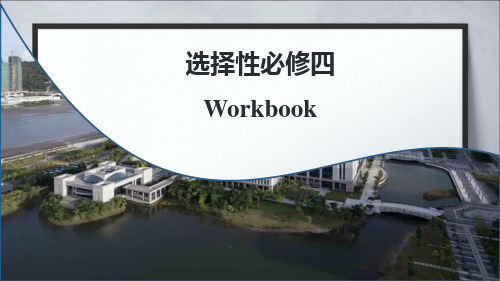
I was 3 shocked to read this and as it had never been 4 told to
me that Ihad other family members. The letter said my
sister would like to meet me and told me the time and
They emailed a 4 random / ransom group of people and asked them to participate. This smal 5 simple / sample of people were then sent a 6 protective / package to pass on to a stranger by sending it to someone they knew.
As a 6__c_o_n_s_e_q_u_e__n_c_e____ of this, many people who could afford to, left for other areas. We asked the local council to provide 7_a_d__d_it_io_n_a_l___police but they said they could not.
78页 10.2 2 Lesson 2 Complete the paragraph with the correct form of the words or phrase below. crime additional community spirit frequently consequence household bond suburb conflict envy
Efficient Algorithms for Citation Network Analysis
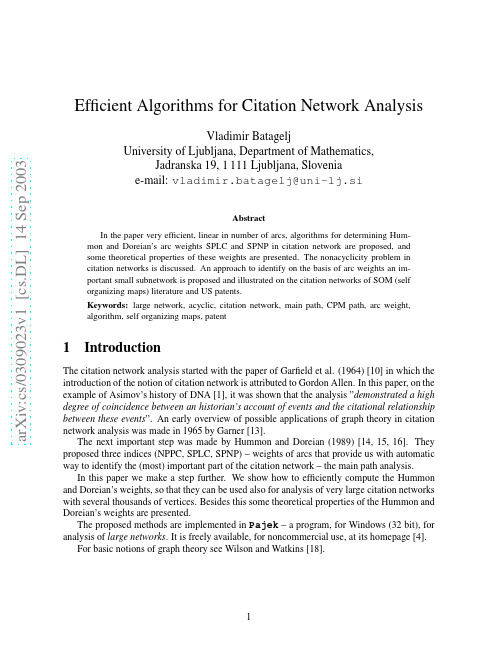
a r X i v :c s /0309023v 1 [c s .D L ] 14 S e p 2003Efficient Algorithms for Citation Network AnalysisVladimir BatageljUniversity of Ljubljana,Department of Mathematics,Jadranska 19,1111Ljubljana,Slovenia e-mail:vladimir.batagelj@uni-lj.siAbstractIn the paper very efficient,linear in number of arcs,algorithms for determining Hum-mon and Doreian’s arc weights SPLC and SPNP in citation network are proposed,and some theoretical properties of these weights are presented.The nonacyclicity problem in citation networks is discussed.An approach to identify on the basis of arc weights an im-portant small subnetwork is proposed and illustrated on the citation networks of SOM (self organizing maps)literature and US patents.Keywords:large network,acyclic,citation network,main path,CPM path,arc weight,algorithm,self organizing maps,patent1IntroductionThe citation network analysis started with the paper of Garfield et al.(1964)[10]in which the introduction of the notion of citation network is attributed to Gordon Allen.In this paper,on the example of Asimov’s history of DNA [1],it was shown that the analysis ”demonstrated a high degree of coincidence between an historian’s account of events and the citational relationship between these events ”.An early overview of possible applications of graph theory in citation network analysis was made in 1965by Garner [13].The next important step was made by Hummon and Doreian (1989)[14,15,16].They proposed three indices (NPPC,SPLC,SPNP)–weights of arcs that provide us with automatic way to identify the (most)important part of the citation network –the main path analysis.In this paper we make a step further.We show how to efficiently compute the Hummon and Doreian’s weights,so that they can be used also for analysis of very large citation networks with several thousands of vertices.Besides this some theoretical properties of the Hummon and Doreian’s weights are presented.The proposed methods are implemented in Pajek –a program,for Windows (32bit),for analysis of large networks .It is freely available,for noncommercial use,at its homepage [4].For basic notions of graph theory see Wilson and Watkins [18].Table1:Citation network characteristicsnetwork m n0k C∆in24 DNA6013700 2231218161340 Small world198816316000 105911024282320 Cocitation49293519020 308412678321052 Kroto319500116660 447023704247350 Zewail542531015166382 8843782126310984 Desalination25751141111573121 377476813764117327700Figure1:Citation Network in Standard FormLet I={(u,u):u∈U}be the identity relation on U andQ∩I=∅.The relation Q⋆=3Analysis of Citation NetworksAn approach to the analysis of citation network is to determine for each unit/arc its impor-tance or weight.These values are used afterward to determine the essential substructures in the network.In this paper we shall focus on the methods of assigning weights w:R→I R+0to arcs proposed by Hummon and Doreian[14,15]:•node pair projection count(NPPC)method:w d(u,v)=|R inv⋆(u)|·|R⋆(v)|•search path link count(SPLC)method:w l(u,v)equals the number of”all possible search paths through the network emanating from an origin node”through the arc(u,v)∈R, [14,p.50].•search path node pair(SPNP)method:w p(u,v)”accounts for all connected vertex pairs along the paths through the arc(u,v)∈R”,[14,p.51].3.1Computing NPPC weightsTo compute w d for sets of units of moderate size(up to some thousands of units)the matrix representation of R can be used and its transitive closure computed by Roy-Warshall’s algorithm [9].The quantities|R⋆(v)|and|R inv⋆(u)|can be obtained from closure matrix as row/column sums.An O(nm)algorithm for computing w d can be constructed using Breath First Search from each u∈U to determine|R inv⋆(u)|and|R⋆(v)|.Since it is of order at least O(n2)this algorithm is not suitable for larger networks(several ten thousands of vertices).3.2Search path count methodTo compute the SPLC and SPNP weights we introduce a related search path count(SPC) method for which the weights N(u,v),uRv count the number of different paths from s to t (or from Min R to Max R)through the arc(u,v).To compute N(u,v)we introduce two auxiliary quantities:let N−(v)denotes the number of different s-v paths,and N+(v)denotes the number of different v-t paths.Every s-t pathπcontaining the arc(u,v)∈R can be uniquely expressed in the formπ=σ◦(u,v)◦τwhereσis a s-u path andτis a v-t path.Since every pair(σ,τ)of s-u/v-t paths gives a corresponding s-t path it follows:N(u,v)=N−(u)·N+(v),(u,v)∈RwhereN−(u)= 1u=sv:vRu N−(v)otherwiseandN+(u)= 1u=tv:uRv N+(v)otherwiseThis is the basis of an efficient algorithm for computing the weights N(u,v)–after the topo-logical sort of the network[9]we can compute,using the above relations in topological order, the weights in time of order O(m).The topological order ensures that all the quantities in the right side expressions of the above equalities are already computed when needed.The counters N(u,v)are used as SPC weights w c(u,v)=N(u,v).3.3Computing SPLC and SPNP weightsThe description of SPLC method in[14]is not very precise.Analyzing the table of SPLC weights from[14,p.50]we see that we have to consider each vertex as an origin of search paths.This is equivalent to apply the SPC method on the extended network N l=(U′,R l)R l:=R′∪{s}×(U\∪R(s))It seems that there are some errors in the table of SPNP weights in[14,p.51].Using the definition of the SPNP weights we can again reduce their computation to SPC method applied on the extended network N p=(U′,R p)R p:=R∪{s}×U∪U×{t}∪{(t,s)}in which every unit u∈U is additionaly linked from the source s and to the sink t.3.4Computing the numbers of paths of length kWe could use also a direct approach to determine the weights w p.Let L−(u)be the number of different paths terminating in u and L+(u)the number of different paths originating in u.Then for uRv it holds w p(u,v)=L−(u)·L+(v).The procedure to determine L−(u)and L+(u)can be compactly described using two fami-lies of polynomial generating functionsP−(u;x)=h(u)k=0p−(u,k)x k and P+(u;x)=h−(u)k=0p+(u,k)x k,u∈Uwhere h(u)is the depth of vertex u in network(U,R),and h−(u)is the depth of vertex u in network(U,R inv),The coefficient p−(u,k)counts the number of paths of length k to u,and p+(u,k)counts the number of paths of length k from u.Again,by the basic principles of combinatoricsP−(u;x)= 0u=s1+x· v:vRu P−(v;x)otherwiseandP+(u;x)= 0u=t1+x· v:uRv P+(v;x)otherwiseand both families can be determined using the definitions and computing the polynomials in the(reverse for P+)topological ordering of U.The complexity of this procedure is at most O(hm).FinallyL−(u)=P−(u;1)and L+(v)=P+(v;1)In real life citation networks the depth h is relatively small as can be seen from the Table 1.The complexity of this approach is higher than the complexity of the method proposed in subsection 3.3–but we get more detailed information about paths.May be it would make sense to consider ’aging’of references by L −(u )=P −(u ;α),for selected α,0<α≤1.3.5Vertex weightsThe quantities used to compute the arc weights w can be used also to define the corresponding vertex weights tt d (u )=|R inv ⋆(u )|·|R ⋆(u )|t c (u )=N −(u )·N +(u )t l (u )=N ′−(u )·N ′+(u )t p (u )=L −(u )·L +(u )They are counting the number of paths of selected type through the vertex u .3.6Implementation detailsIn our first implementation of the SPNP method the values of L −(u )and L +(u )for some large networks (Zewail and Lederberg)exceeded the range of Delphi’s LargeInt (20decimal places).We decided to use the Extended real numbers (range =3.6×10−4951..1.1×104932,19-20significant digits)for counters.This range is safe also for very large citation networks.To see this,let us denote N ∗(k )=max u :h (u )=k N −(u ).Note that h (s )=0and uRv ⇒h (u )<h (v ).Let u ∗∈U be a unit on which the maximum is attained N ∗(k )=N −(u ∗).ThenN ∗(k )=v :vRu ∗N −(v )≤v :vRu ∗N ∗(h (v ))≤v :vRu ∗N ∗(k −1)==deg in (u ∗)·N ∗(k −1)≤∆in (k )·N ∗(k −1)where ∆in (k )is the maximal input degree at depth k .Therefore N ∗(h )≤ hk =1∆in (k )≤∆h in .A similar inequality holds also for N +(u ).From both it followsN (u,v )≤∆h (u )in ·∆h −(v )out≤∆H −1where H =h (t )and ∆=max(∆in ,∆out ).Therefore for H ≤1000and ∆≤10000we getN (u,v )≤∆H −1≤104000which is still in the range of Extended reals.Note also that in the derivation of this inequality we were very generous –in real-life networks N (u,v )will be much smaller than ∆H −1.Very large/small numbers that result as weights in large networks are not easy to use.One possibility to overcome this problem is to use the logarithms of the obtained weights –logarith-mic transformation is monotone and therefore preserve the ordering of weights (importance of vertices and arcs).The transformed values are also more convenient for visualization with line thickness of arcs.4Properties of weights4.1General properties of weightsDirectly from the definitions of weights we getw k(u,v;R)=w k(v,u;R inv),k=d,c,pandw c(u,v)≤w l(u,v)≤w p(u,v)Let N A=(U A,R A)and N B=(U B,R B),U A∩U B=∅be two citation networks,andN1=(U′A,R′A)and N2=((U A∪U B)′,(R A∪R B)′)the corresponding standardized networks of thefirst network and of the union of both networks.Then it holds for all u,v∈U A and for all p,q∈R At(1)k(u)t(2)k(v),andw(1)k(p)w(2)k(q),k=d,c,l,pwhere t(1)and w(1)is a weight on network N1,and t(2)and w(2)is a weight on network N2.This means that adding or removing components in a network do not change the ratios(ordering)of the weights inside components.Let N1=(U,R1)and N2=(U,R2)be two citation networks over the same set of units U and R1⊆R2thenw k(u,v;R1)≤w k(u,v;R2),k=d,c,p4.2NPPC weightsIn an acyclic network for every arc(u,v)∈R holdR inv⋆(u)∩R⋆(v)=∅and R inv⋆(u)∪R⋆(v)⊆Utherefore|R inv⋆(u)|+|R⋆(v)|≤n and,using the inequality √2(a+b),alsow d(u,v)=|R inv⋆(u)|·|R⋆(v)|≤1Rv⇒R⋆(u)⊂R⋆(v)The weights w d are larger in the’middle’of the network.A more uniform(but less sensitive)weight would be w s(u,v)=|R inv⋆(u)|+|R⋆(v)|or in the normalized form w′s(u,v)=14.3SPC weightsFor theflow N(u,v)the Kirchoff’s node law holds:For every node v in a citation network in standard form it holdsincomingflow=outgoingflow=t c(v)Proof:N(x,v)= x:xRv N−(x)·N+(v)=( x:xRv N−(x))·N+(v)=N−(v)·N+(v) x:xRvN(v,y)= y:vRy N−(v)·N+(y)=N−(v)· y:vRy N+(y)=N−(v)·N+(v) y:vRy2 From the Kirchoff’s node law it follows that the totalflow through the citation network equals N(t,s).This gives us a natural way to normalize the weightsN(u,v)w(u,v)=Figure2:Preprint transformationBut,new problems arise:What is the right value of the’aging’factor?Is there an efficient algorithm to count the restricted trails?The other possibility,since a citation network is usually almost acyclic,is to transform it into an acyclic network•by identification(shrinking)of cyclic groups(nontrivial strong components),or •by deleting some arcs,or•by transformations such as the’preprint’transformation(see Figure2)which is based on the following idea:Each paper from a strong component is duplicated with its’preprint’version.The papers inside strong component cite preprints.Large strong components in citation network are unlikely–their presence usually indicates an error in the data.An exception from this rule is the citation network of High Energy Particle Physics literature[20]from arXiv.In it different versions of the same paper are treated as a unit.This leads to large strongly connected components.The idea of preprint transformation can be used also in this case to eliminate cycles.6First Example:SOM citation networkThe purpose of this example is not the analysis of the selected citation network on SOM(self-organizing maps)literature[12,24,23],but to present typical steps and results in citation net-work analysis.We made our analysis using program Pajek.First we test the network for acyclicity.Since in the SOM network there are11nontrivial strong components of size2,see Table1,we have to transform the network into acyclic one.We decided to do this by shrinking each component into a single vertex.This operation produces some loops that should be removed.Figure3:Main path and CPM path in SOM network with SPC weights Now,we can compute the citation weights.We selected the SPC(search path count)method. It returns the following results:the network with citation weights on arcs,the main path network and the vector with vertex weights.In a citation network,a main path(sub)network is constructed starting from the source vertex and selecting at each step in the end vertex/vertices the arc(s)with the highest weight, until a sink vertex is reached.Another possibility is to apply on the network N=(U,R,w)the critical path method (CPM)from operations research.First we draw the main path network.The arc weights are represented by the thickness of arcs.To produce a nice picture of it we apply the Pajek’s macro Layers which contains a sequence of operations for determining a layered layout of an acyclic network(used also in analysis of genealogies represented by p-graphs).Some experiments with settings of different options are needed to obtain a right picture,see left part of Figure3.In its right part the CPMTable2:15Hubs and AuthoritiesRank Hub Id Authority Id1CLARK-JW-1991-V36-P1259HOPFIELD-JJ-1982-V79-P25540.063660.334273HUANG-SH-1994-V17-P212KOHONEN-T-1990-V78-P14640.057210.123985SHUBNIKOV-EI-1997-V64-P989#GARDNER-E-1988-V21-P2570.054960.093537VEMURI-V-1993-V36-P203MCELIECE-RJ-1987-V33-P4610.054090.076569BUSCEMA-M-1998-V33-P17RUMELHART-DE-1985-V9-P750.052580.0727111WELLS-DM-1998-V41-P173ANDERSON-JA-1977-V84-P4130.052330.0703313SMITH-KA-1999-V11-P15KOSKO-B-1987-V26-P49470.051490.0580215KOHONEN-T-1990-V78-P1464GROSSBERG-S-1987-V11-P23 path is presented.We see that the upper parts of both paths are identical,but they differ in the continuation. The arcs in the CPM path are thicker.We could display also the complete SOM network using essentially the same procedure as for the displaying of main path.But the obtained picture would be too complicated(too many vertices and arcs).We have to identify some simpler and important subnetworks inside it.Inspecting the distribution of values of weights on arcs(lines)we select a threshold0.007 and determine the corresponding arc-cut–delete all arcs with weights lower than selected threshold and afterwards delete also all isolated vertices(degree=0).Now,we are ready to draw the reduced network.Wefirst produce an automatic layout.We notice some small unimportant components.We preserve only the large main component,draw it and improve the obtained layout manually.To preserve the level structure we use the option that allows only the horizontal movement of vertices.Finally we label the’most important vertices’with their labels.A vertex is considered important if it is an endpoint of an arc with the weight above the selected threshold(in our case 0.05).The obtained picture of SOM’main subnetwork’is presented in Figure4.We see that the SOMfield evolved in two main branches.From CARPENTER-1987the strongest(main path) arc is leading to the right branch that after some steps disappears.The left,more vital branch is detected by the CPM path.Further investigation of this is left to the readers with additional knowledge about the SOMfield.As a complementary information we can determine Kleinberg’s hubs and authorities vertex weights[17].Papers that are cited by many other papers are called authorities;papers that cite many other documents are called hubs.Good authorities are those that are cited by good hubsFigure4:Main subnetwork at level0.007and good hubs cite good authorities.The15highest ranked hubs and authorities are presented in Table2.We see that the main authorities are located in eighties and the main hubs in nineties. Note that,since we are using the relation uRv≡u is cited by v,we have to interchange the roles of hubs and authorities produced by Pajek.An elaboration of the hubs and authorities approach to the analysis of citation networks complemented with visualization can be found in Brandes and Willhalm(2002)[8].7Second Example:US patentsThe network of US patents from1963to1999[21]is an example of very large network (3774768vertices and16522438arcs)that,using some special options in Pajek,can still be analyzed on PC with at least1G memory.The SPC weights are determined in a range of1 minute.This shows that the proposed approach can be used also for very large networks.The obtained main path and CPM path are presented in Figure5.Collecting from the United States Patent and Trademark Office[22]the basic data about the patents from both paths,see Table3-6,we see that they deal with’liquid crystal displays’.But,in this network there should be thousands of’themes’.How to identify them?Using the arc weights we can define a theme as a connected small subnetwork of size in the interval k ..K(for example,between k=1Table3:Patents on the liquid-crystal display patent author(s)and titleMar13,1951Jun29,1954May30,1967May19,1970Jan18,1972May30,1972Jul11,1972Sep19,1972Oct10,1972May8,1973Jun19,1973Oct23,1973Nov20,1973Mar5,1974Mar12,1974Apr23,1974May7,1974Mar18,1975Apr8,1975May6,1975Jun24,1975Mar30,1976May4,1976Jun1,1976Aug17,1976Dec28,1976Mar8,1977Mar22,1977Apr12,1977Table4:Patents on the liquid-crystal display patent author(s)and titleJun14,1977Jun28,1977Mar7,1978Apr4,1978Apr11,1978Sep12,1978Oct3,1978Dec19,1978Apr17,1979May15,1979Apr1,1980Apr15,1980May13,1980Oct21,1980Apr14,1981Sep22,1981Oct6,1981Nov24,1981May18,1982Jul20,1982Sep14,1982Nov2,1982Nov30,1982Jan11,1983May31,1983Jun7,1983Jun7,1983Aug23,1983Nov15,1983Dec6,1983Dec27,1983Jun19,1984Jun26,1984Jul17,1984Sep18,1984Table5:Patents on the liquid-crystal display patent author(s)and titleSep18,1984Oct30,1984Mar5,1985Apr9,1985Apr30,1985Jul2,1985Nov5,1985Dec10,1985Apr22,1986Nov11,1986Dec23,1986Apr14,1987Apr21,1987Sep22,1987Nov3,1987Nov24,1987Dec1,1987Dec15,1987Jan12,1988Jan26,1988Jun21,1988Sep13,1988Jan3,1989Jan10,1989Apr11,1989May23,1989Oct31,1989Sep18,1990May21,1991May21,1991Jun16,1992Jun23,1992Dec15,1992Dec29,1992Table6:Patents on the liquid-crystal display patent author(s)and titleSep7,1993Feb1,1994May3,1994June7,1994Dec20,1994Apr18,1995Jul23,1996Aug6,1996Sep10,1996Nov4,1997Jun23,1998Jan5,1999Nov23,1999Dec21,19992510205010011001000sizef r e qFigure 6:Island size frequency distributionTable8:Some patents from the’foam’island patent author(s)and titleNov29,1977Sep29,1981Nov2,1982Jul10,1984Jan29,1985Oct1,1985Dec22,1987May22,1990Feb26,1991Dec8,1992Feb16,1993May3,1994Sep24,1996Table9:Some patents from’fiber optics and bags’island patent author(s)and titleJul24,1984Apr16,1985Jul23,1985May20,1986Jun30,1987Jan12,1988Nov15,1988Nov22,1988Mar7,1989Mar7,1989May9,1989Jan1,1991Mar5,1991Feb23,1993May3,1994Nov15,1994The subnetworks approach onlyfilters out the structurally important subnetworks thus pro-viding a researcher with a smaller manageable structures which can be further analyzed using more sophisticated and/or substantial methods.9AcknowledgmentsThe search path count algorithm was developed during my visit in Pittsburgh in1991and pre-sented at the Network seminar[2].It was presented to the broader audience at EASST’94in Budapest[3].In1997it was included in program Pajek[4].The’preprint’transformation was developed as a part of the contribution for the Graph drawing contest2001[5].The al-gorithm for the path length counts was developed in August2002and the Islands algorithm in August2003.The author would like to thank Patrick Doreian and Norm Hummon for introducing him into thefield of citation network analysis,Eugene Garfield for making available the data on real-life networks and providing some relevant references,and Andrej Mrvar and Matjaˇz Zaverˇs nik for implementing the algorithms in Pajek.This work was supported by the Ministry of Education,Science and Sport of Slovenia, Project0512-0101.References[1]Asimov I.:The Genetic Code,New American Library,New York,1963.[2]Batagelj V.:Some Mathematics of Network work Seminar,Department ofSociology,University of Pittsburgh,January21,1991.[3]Batagelj V.:An Efficient Algorithm for Citation Networks Analysis.Paper presented atEASST’94,Budapest,Hungary,August28-31,1994.[4]Batagelj V.,Mrvar A.:Pajek–program for analysis and visualization of large networks.http://vlado.fmf.uni-lj.si/pub/networks/pajek/http://vlado.fmf.uni-lj.si/pub/networks/pajek/howto/extreme.htm [5]Batagelj V.,Mrvar A.:Graph Drawing Contest2001Layoutshttp://vlado.fmf.uni-lj.si/pub/GD/GD01.htm[6]Batagelj V.,Zaverˇs nik M.:Generalized Cores.Submitted,2002./abs/cs.DS/0202039[7]Batagelj V.,Zaverˇs nik M.:Islands–identifying themes in large networks.In preparation,August2003.[8]Brandes U.,Willhalm T.:Visualization of bibliographic networks with a reshaped land-scape metaphor.Joint Eurographics–IEEE TCVG Symposium on Visualization,D.Ebert, P.Brunet,I.Navazo(Editors),2002.http://algo.fmi.uni-passau.de/˜brandes/publications/bw-vbnrl-02.pdf[9]Cormen T.H.,Leiserson C.E.,Rivest R.L.,Stein C.:Introduction to Algorithms,SecondEdition.MIT Press,2001.[10]Garfield E,Sher IH,and Torpie RJ.:The Use of Citation Data in Writing the History ofScience.Philadelphia:The Institute for Scientific Information,December1964./papers/useofcitdatawritinghistofsci.pdf[11]Garfield E.:From Computational Linguistics to Algorithmic Historiography,paper pre-sented at the Symposium in Honor of Casimir Borkowski at the University of Pittsburgh School of Information Sciences,September19,2001./papers/pittsburgh92001.pdf [12]Garfield E.,Pudovkin A.I.,Istomin,V.S.:Histcomp–(comp iled Hist oriography program)/histcomp/guide.html/histcomp/index.html[13]Garner R.:A computer oriented,graph theoretic analysis of citation index structures.Flood B.(Editor),Three Drexel information science studies,Philadelphia:Drexel Univer-sity Press1967./rgarner.pdf[14]Hummon N.P.,Doreian P.:Connectivity in a Citation Network:The Development of DNATheory.Social Networks,11(1989)39-63.[15]Hummon N.P.,Doreian P.:Computational Methods for Social Network Analysis.SocialNetworks,12(1990)273-288.[16]Hummon N.P.,Doreian P.,Freeman L.C.:Analyzing the Structure of the Centrality-Productivity Literature Created Between1948and1979.Knowledge:Creation,Diffusion, Utilization,11(1990)4,459-480.[17]Kleinberg J.:Authoritative sources in a hyperlinked environment.In Proc9th ACMSIAMSymposium on Discrete Algorithms,1998,p.668-677./home/kleinber/auth.ps/kleinberg97authoritative.html[18]Wilson,R.J.,Watkins,J.J.:Graphs:An Introductory Approach.New York:John Wileyand Sons,1990.[19]Pajek’s datasets–citation networks:http://vlado.fmf.uni-lj.si/pub/networks/data/cite/[20]KDD Cup2003:/projects/kddcup/index.html/[21]Hall,B.H.,Jaffe,A.B.and Tratjenberg M.:The NBER U.S.Patent Citations Data File.NBER Working Paper8498(2001)./patents/[22]The United States Patent and Trademark Office./netahtml/srchnum.htm[23]Bibliography on the Self-Organizing Map(SOM)and Learning Vector Quantization(LVQ)a.de/bibliography/Neural/SOM.LVQ.html[24]Neural Networks Research Centre:Bibliography of SOM papers.http://www.cis.hut.fi/research/refs/。
研究生英语系列教材多维教程熟谙课后参考答案含翻译
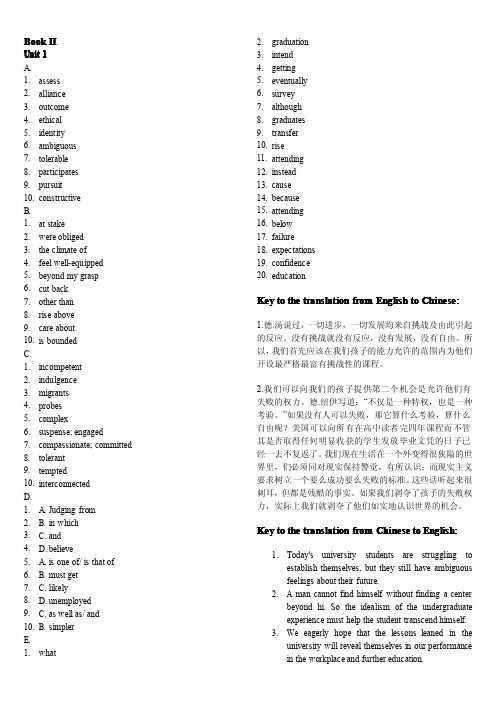
Book IIUnit1A.1.assess2.alliance3.outcome4.ethical5.identity6.ambiguous7.tolerable8.participates9.pursuit10.constructiveB.1.at stake2.were obliged3.the climate of4.feel well-equipped5.beyond my grasp6.cut back7.other than8.rise above9.care about10.is boundedC.1.incompetent2.indulgence3.migrants4.probesplex6.suspense;engagedpassionate;committed8.tolerant9.tempted10.interconnectedD.1. A.Judging from2. B.in which3. C.and4. D.believe5. A.is one of/is that of6. B.must get7. C.likely8. D.unemployed9. C.as well as/and10.B.simplerE.1.what2.graduation3.intend4.getting5.eventually6.survey7.although8.graduates9.transfer10.rise11.attending12.instead13.cause14.because15.attending16.below17.failure18.expectations19.confidencecationKey to the translation from English to Chinese:1.德.汤说过,一切进步,一切发展均来自挑战及由此引起的反应。
没有挑战就没有反应,没有发展,没有自由。
高级商务英语听说(第二版)Unit 9 Recruitment Performance Appraisal[精]
![高级商务英语听说(第二版)Unit 9 Recruitment Performance Appraisal[精]](https://img.taocdn.com/s3/m/5ef3a1386c85ec3a87c2c5f2.png)
7. be impressed by We _w_e_r_e_im__p_r_e_ss_e_d__b_y its features - especially its management tools
8. transform from…to
GroteApproach helps organizations transform _p_e_rf_o_r_m_a_n_c_e_ management f_r_o_m_ a frenzied series of events _to_ a well-defined, continuous, effective process. 9. tie…to The system __t_ie_s__ an organization's goals, mission statement, vision and values __to_ performance management in order to achieve critical organizational objectives.
University of International Business and Economics
3. Some researchers think feedback is particularly useful when workers have an achievement objective? Do you agree?
英语泛读教程 4 Unit 9 Diplomatic relationship

Five
After the WW2
One
March 13, 1973: ambassadorial level relation Joint Communiquéof the United Kingdom of Great Britain and Northern Ireland and the People's Republic of China
• The emperor was Qianlong. • The whole country was rich and powerful but also insular.
Two
Three
Four
• Had finished the first Industrial Revolution and became an advanced country. • In desperate need of enlarging its market and exploring the mystical East world.
Three
Four
Five
After the WW2
One
Two
Other western countries such as the US had established the diplomatic relationship with China China was seriously threatened by the Soviet Union at that time, searching for developing relationships with western countries
Three
Four
Five
新媒体商务英语阅读 Unit4 Frauds and Cyber-hacking
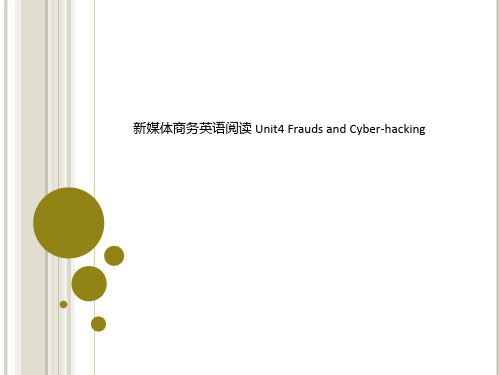
Exercise TEXT
III
Could You Be Sending Your Firm's Cash to Fraudsters?
Fill in the blanks with a word or phrase from the box.
2020/12/13 Leabharlann 渝-新媒体商务英语阅读 Unit 4
8. What can staff do to prevent email fraud?
• to look out for tell-tale signs in emails, such as domain names that differ very slightly from their company's; • by ensuring staff question any
whether the terms of the contract have
been fulfilled.
7
2020/12/13 顾渝-新媒体商务英语阅读 Unit 4
Exercise TEXT
I
Could You Be Sending Your Firm's Cash to Fraudsters?
an aspiration an attack a shutdown challenge cyber-capabilities cyber-security frustration response-and-recovery threat
over the odds more than something is really worth: It's a nice enough car but I'm sure she paid over the odds for it.
网络英语
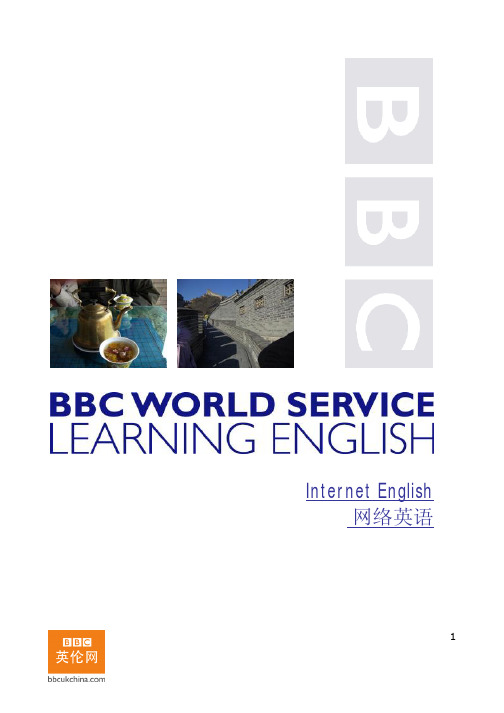
1Internet English网络英语2Internet English 网络英语How Is the Internet Changing English? 网络如何改变英语语言?Read the text below and do the activity that follows. 阅读下面的短文,然后完成练习:Twenty years ago this week the British inventor Tim Berners-Lee created the world’s first webpage. It is worth pausing to consider the extraordinary impact that his invention has had on the English language.Everyday words like google, unfriend and app simply didn’t exist in 1990.Even more words have had unexpected shifts in meaning in those twodecades. If you had mentioned tweeting to an English-speaker a few years ago, he would have assumed you were talking about bird noises, not the use of the microblogging site Twitter.Long ago, if someone lived online, it didn’t mean they spent every waking minute on the internet, but that they travelled around with the rail network.And wireless still means, to anyone of a certain age , a radio – not the system for retrieving internet pages without wires."The internet is an amazing medium for languages," said David Crystal,honorary professor of linguistics at the University of Bangor. "Language itself changes slowly but the internet has speeded up the process of those changes so you notice them more quickly."English is a remarkably inclusive language, and if words continue to be used for at least five years they generally end up in the Oxford English Dictionary.But less accepted are the peculiar dialects that have sprung up amongst some users. For example, ‘LOLcat’ is a phonetic , grammatically-incorrect caption that accompanies a picture of a cat, like "I’m in ur bed zleeping".In an article called "Cats Can Has Grammar" the blogger Anil Dash referred to LOLcat as "kitty pidgin ". But does something like LOLcat have the staying power to become an accepted form of English?Not according to Professor Crystal. "They are all clever little developments used by a very small number of people – thousands rather than millions. Will they be around in 50 years' time? I would be very surprised."3Glossary 词汇表to unfriend – 删除好友 app – 应用程序microblogging – 微博every waking minute – 醒着的每一分钟of a certain age – 中年的,不算年轻的to retrieve – 找回 medium – 媒介 linguistics – 语言学 to speed up – 加速 inclusive – 包容广泛的 to end up – 最终成为 to be accepted – 被接受 dialect – 方言 to spring up – 涌现phonetic – 语音学的caption - (图片、照片等)说明文字 to accompany something – 伴随、陪伴某物blogger – 写博客的人 kitty pidgin – 像猫语言的混杂语 staying power – 持久力1. Reading Quiz 阅读测验Are these sentences true or false? Circle the correct answer.以下句子哪句是真?哪句是假?请圈出正确答案。
Experience Summary
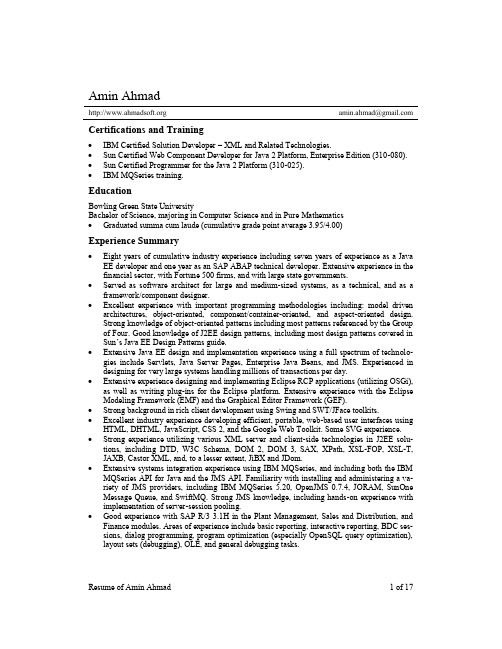
Amin Ahmad amin.ahmad@ Certifications and Training∙IBM Certified Solution Developer – XML and Related Technologies.∙Sun Certified Web Component Developer for Java 2 Platform, Enterprise Edition (310-080). ∙Sun Certified Programmer for the Java 2 Platform (310-025).∙IBM MQSeries training.EducationBowling Green State UniversityBachelor of Science, majoring in Computer Science and in Pure Mathematics∙Graduated summa cum laude (cumulative grade point average 3.95/4.00)Experience Summary∙Eight years of cumulative industry experience including seven years of experience as a Java EE developer and one year as an SAP ABAP technical developer. Extensive experience in the financial sector, with Fortune 500 firms, and with large state governments.∙Served as software architect for large and medium-sized systems, as a technical, and as a framework/component designer.∙Excellent experience with important programming methodologies including: model driven architectures, object-oriented, component/container-oriented, and aspect-oriented design.Strong knowledge of object-oriented patterns including most patterns referenced by the Group of Four. Good knowledge of J2EE design patterns, including most design patterns covered in Sun’s Java EE Design Patterns guide.∙Extensive Java EE design and implementation experience using a full spectrum of technolo-gies include Servlets, Java Server Pages, Enterprise Java Beans, and JMS. Experienced in designing for very large systems handling millions of transactions per day.∙Extensive experience designing and implementing Eclipse RCP applications (utilizing OSGi), as well as writing plug-ins for the Eclipse platform. Extensive experience with the Eclipse Modeling Framework (EMF) and the Graphical Editor Framework (GEF).∙Strong background in rich client development using Swing and SWT/JFace toolkits.∙Excellent industry experience developing efficient, portable, web-based user interfaces using HTML, DHTML, JavaScript, CSS 2, and the Google Web Toolkit. Some SVG experience.∙Strong experience utilizing various XML server and client-side technologies in J2EE solu-tions, including DTD, W3C Schema, DOM 2, DOM 3, SAX, XPath, XSL-FOP, XSL-T, JAXB, Castor XML, and, to a lesser extent, JiBX and JDom.∙Extensive systems integration experience using IBM MQSeries, and including both the IBM MQSeries API for Java and the JMS API. Familiarity with installing and administering a va-riety of JMS providers, including IBM MQSeries 5.20, OpenJMS 0.7.4, JORAM, SunOne Message Queue, and SwiftMQ. Strong JMS knowledge, including hands-on experience with implementation of server-session pooling.∙Good experience with SAP R/3 3.1H in the Plant Management, Sales and Distribution, and Finance modules. Areas of experience include basic reporting, interactive reporting, BDC ses-sions, dialog programming, program optimization (especially OpenSQL query optimization), layout sets (debugging), OLE, and general debugging tasks.Resume of Amin Ahmad 1 of 17∙Good experience administering BEA WebLogic 8 and 9, including configuring clustering.Also experienced in deploying J2EE applications to IBM WebSphere (2.03, 3.5, 4.0, 5.0), Jakarta Tomcat (3, 4, 5, and 6 series).∙Experience with JDBC 2, SQL, and a number of RDBMS systems including DB2, UDB, Oracle, Firebird (Interbase branch), MySQL, and Access. Have defined schemas in the fifth normal form (5NF) through DDL following SQL 92 standards, and of implementing indices, synthetic keys, and de-normalization as appropriate to improve performance.∙Experience with UML design, especially using sequence and class diagrams. Experience with Rational Rose and Omondo UML.∙Excellent experience with several industry-standard Java integrated development environ-ments, including Visual Age 3.5, Eclipse 1.0, 2.1.x, 3.x, and, to a lesser extent, WebSphere Studio Application Developer 4.0 and 5.0, and Forte for Java, Community Edition.∙Experienced in designing and implementing modular build systems with inbuilt quality con-trol mechanisms using Ant 1.5 and Ant 1.6.∙Good experience with many quality control and testing tools, including JUnit, JProbe, hprof, OptimizeIt, Pasta Package Analyzer, CodePro Code Audit, Clover Code Coverage, and Sun DocCheck Doclet.∙Excellent experience with SVN and CVS version control systems, including Eclipse integra-tion. Some experience with CMVC, including authoring a CMVC plug-in to provide Eclipse1.0 and WSAD integration.∙Good experience with issue management systems including Bugzilla and Mantis. Experience installing and administering Mantis.∙Some Python 2.4.1 scripting experience.∙Enjoy typesetting using the Miktex distribution of TeX and LaTeX. Experienced in typeset-ting Arabic-script languages using ArabTex.∙ A background in helping others improve their technical skills: Mentored junior and mid-level programmers; published a variety of articles including for IBM DeveloperWorks; served as a technical interviewer for American Management Systems and as an instructor on Java funda-mentals for American Express; participated as a presenter in several J2EE Architecture fo-rums at American Express.∙Demonstrated desire to contribute to the open source software community. I maintain five GPL and LGPL software projects.∙Excellent communication skills and a strong desire to develop high-quality software. Employment HistoryCGI, Inc. October 2006 – August 2007Sr. Java EE consultant for Florida Safe Families Network (FSFN)—a large welfare automation project servicing approximately 70,000 transactions per hour. Responsible for system integration, security integration, team mentoring, and infrastructure development.∙Responsible for integrating FSFN authentication with IBM Tivoli Directory Server. Designed and implemented a JNDI-based solution using LDAP custom controls to parse extended serv-er response codes. The solution also implemented a custom pooling solution that was stress tested to over 5,000 authentications per minute.Resume of Amin Ahmad 2 of 17∙Designed and implemented a single sign on mechanism for FSFN and the Business Objects-based reporting subsystem. Designed and supervised implementation of data synchronization logic between the two systems.∙Involved in design and implementation of auditing infrastructure, whereby the details of any transaction in the system can be recalled for later analysis.∙Extensive infrastructure development, including:1.Configuration of WebLogic 9 server environments, include clustered environments. Ex-tensive work with node manager and Weblogic plugin for Apache. Implemented automat-ic pool monitor/re-starter tool using JMX.2.Developed and implemented improved standards for build versioning. Automated a va-riety of build, deployment, and code delivery tasks, including JSP compilation usingJSPC for WebLogic. This involved extensive use of Ant 1.7 and bash scripting.3.Extensive configuration of Apache, including configuring proxies, reverse proxies, instal-ling PHP, and the Apache Tomcat Connector.4.Created and administered MoinMoin 1.5.7 wiki to track environment information and toserve as a general developer wiki.5.Designed and implemented backup jobs and automated system checks using cron.∙Collaborated on design and implementation of search modules, including person search.1.Double metaphone (SOUNDEX), nickname, wildcard, and exact searches based on first,middle and last names. Over twenty available search criteria including a variety of demo-graphics such as age and address.2.Round trip time of under 10 seconds for complex searches returning 100,000+ results,and near-instantaneous results for most common searches. Achieving this level of per-formance required extensive manipulation of clustering and non-clustering indexes on the DB2 8.1 mainframe system, as well as work with stored procedures, JDBC directional re-sult sets, and absolute cursor positioning.∙Designed and implemented various data migration tools in Java.∙Tasked with ensuring that all developers were able to work productively on their topics. This mainly involved helping developers troubleshoot Struts, JSP, and JavaScript issues, and im-proving their knowledge of these languages and frameworks.Freescale Semiconductor August 2006 – September 2006 Collaborated on design and development of Eclipse 3.2.x-based port of Metrowerks CodeWar-rior’s command window functionality.∙Implemented a wide variety of shell features including tab-based auto-completion, auto-completion of file system paths, scrollable command history, user-configurable font face and color, and custom key bindings. This required, among other things:1.Implementation of custom SWT layouts.2.Extensive use of JFlex for lexical analysis of output data streams for auto-coloration. Resume of Amin Ahmad 3 of 173.Changes to standard image conversion process to preserve alpha values when movingbetween Sun J2SE and SWT image formats.Webalo January 2006 – August 2006 Sr. Software EngineerResp onsible for research and development of Webalo’s suite of Java-based, web-service based mobile middleware.∙Implemented a Java MIDP 2.0, CLDC 1.1-based ―Webalo User Agent‖. The Webalo User Agent resides on a user’s mobile device and allows interaction with enterprise data exposed through web services.1.Conducted research of the U.S. mobile phone market to (a) determine compatibility ofthe MIDP Webalo User Agent with phones currently in use, and to (b) determine if sim-ple changes to the technology stack could improve its compatibility.2.Implemented a custom data-grid component, optimized for low-resolution devices, withadvanced features such as automatic layout, tooltip support, column selection, and drill down support. Conducted extensive testing against a Samsung A880 device.3.Implemented a high performance, memory efficient XML parser suitable for use in anembedded environment, using JFlex 1.4.1. The parser has a smaller codebase, smaller memory footprint, faster parsing times, and fewer bugs than the older, hand-written re-cursive-decent parser.4.Focused on optimizing distribution footprint of the Webalo User Agent without sacrific-ing compatibility. Ultimately reduced size from 1.2MB to 270KB using an extensive tool chain including Pngcrush, ImageMagick 6.2.9, ProGuard 3.0, and 7-zip.5.Extensive use of Sun’s Wireless Java Toolkit 2.3 and 2.5, EclipseME, and AntennaHouse J2ME extensions for Ant. To a lesser extent, performed testing of the Webalo User Agent using MIDP toolkits from Samsung, Motorola, Sprint, and Palm (Treo 650 and 700 series).∙Designed and implemented JMX-based system monitoring for the Webalo Mobile Dashboard.Also, implemented a web-based front-end for accessing system monitoring information.∙Worked on the design and implementation of a Flash-based, mobile mashup service designer.1.Extended Webalo’s existing, proprietary tool for converting Java code to ActionScript byadding support for converting inner classes, anonymous inner classes, overloaded me-thods, and shadowed fields. Use was made of JavaCC and The Java Language Specifica-tion, Second Edition.2.Designed and implemented a framework for remote service invocation from the Flashclient to the Java EE-based server. Significant features of the framework include an XML-based serialization format and a remote proxy generator written in Java.3.Wrote Flash-based UI Framework on which the various mashup-related wizards thatcomprise the product are implemented.4.Implemented a library of XML functions with an API that is compatible in both Java andFlash environments.eCredit August 2005 – August 2006 Responsible for the end-to-end design and implementation of a visual authoring environment for commercial credit and collections processes.Resume of Amin Ahmad 4 of 17∙The authoring environment is implemented atop the Eclipse Rich Client Platform (Eclipse RCP), version 3.1, running Java 5.0. Design and development are bridged through the use of a model driven architecture, using EMF, version 2.2. The visual editor component of the system is implemented using the Graphical Editor Framework (GEF).∙Business processes are serialized into XML format for easy interchange with other systems. ∙Implemented a Windows-based installer using the Nullsoft Scriptable Install System (NSIS). Ohio Department of Taxation June 2005 – August 2005 Independent ConsultantConsulted on the design and implementation of a J2EE-based taxation system for handling taxpayer registration, returns, and workflow requirements. The system has the following characte-ristics:∙DB2 v8.0 was used as a data store and triggers were utilized extensively to implement data auditing requirements.∙Business logic was implemented within WebSphere 5.0 using EJB session and entity beans. ∙ A standard Model 2 architecture was implemented utilizing Jakarta Struts and the Tiles Document Assembly Framework.Expertise was also provided in the following areas:∙Implementation of a data access service. Wherever possible, the layered service implements component design principles such as inversion-of-control. Key features include:1.Automatic data pagination, which is a key to maintaining service level requirements.2. A scheme to decouple the work of query authors from the user interface designers.3.All aspects of a data access instance (query) are located in a cohesive, class-based unit. ∙Reviewed logical schema model. Provided feedback for indices, normalization opportunities, as well as general enhancements in the light of business requirements.∙Design of database population and deletion scripts.∙Definition of a strategy for automated quality assurance using Load Runner.∙Extensions to Struts custom tags to improve productivity of the user interface team.∙Training and mentoring developers.NYSE, New York Stock Exchange February 2005 – May 2005 Independent ConsultantServed as a senior consultant for the design and implementation of a fraud tracking system. Business logic was implemented within WebSphere 5.0, while the front-end rich client was implemented atop the Eclipse platform. Expertise was provided in the following areas:∙Formulated a JUnit-based unit testing strategy for server side business components, and provided an initial proof-of-concept.∙Proposed procedures for basic incident tracking, as well as procedures for utilizing JUnit for regression testing of incidents. Provided a proof-of-concept system using Mantis 1.0.0 run-ning on Apache HTTP Server and MySQL.∙Audited logging procedures within server-side business logic and made several proposals, including the use of Log4J nested diagnostic contexts to improve the ability to correlate log-ging statements.∙Audited server-side security model and issued several recommendations.∙Implemented a rigorous type system to increase front-end developer productivity and provided a detailed, three-stage roadmap for its evolution.Resume of Amin Ahmad 5 of 17∙Performed a comprehensive audit of the rich-client tier of the application and issued a findings report. Also performed a small-scale feasibility analysis on the use of the Eclipse Modeling Framework to improve productivity.∙Designed and implemented a data grid component to standardize display and manipulation of tabular data within the system. Key features include:1. A user interface modeled after Microsoft Excel and Microsoft Access. Features of theuser interface include column reordering, column show/hide, record-set navigator, selec-tion indicators, and row numbering.2.Support for multi-column sorting, multi-column filter specification using Boolean sheetsand supporting a variety of match operators including regular expressions.3.Support for persistent sort and filter profiles, column ordering, and column widths usingthe java.util.prefs API.4.Microsoft Excel data export.5. A developer API that greatly simplifies loading data stored in Java Beans.6.Data formatting is tightly integrated with the application’s type system.eCredit September 2004 – January 2005 Served as a senior resource in the design and implementation of the Mobius Process Development Environment (PDE). The PDE, which serves as a business rules and process flow authoring sys-tem for the Mobius business process engine, is provided as a feature for Eclipse 3.1 and Java 5.0. ∙Designed and implemented a shared workspace using Jakarta Slide 2.1 WebDAV repository.The client view of the repository is represented using an EMF 2.1 native ECore model that is loaded and persisted during plug-in activation and deactivation, and provides support for workspace synchronization, asynchronous deep and shallow refresh, locking and unlocking of resources, check-in and check-out capabilities, and a drag and drop operation for resources. In addition, a WebDAV-compliant recycle bin was implemented. Etag-based content caching was implemented to improve workspace performance. Responsiveness was increased through heavy use is made of the Eclipse 3.0 Job API.∙Designed and implemented a secure licensing model for the PDE. Licenses, which contain roles and their expiration dates for a specific principal, are obtained from a licensing server after providing a valid license key. Licenses are signed by the licensing server to prevent modification and encrypted us ing the PDE client’s public key to prevent unauthorized access.Implementation entailed the use of strong (2048 bit) RSA-based X.509 certificates for license signing and symmetric key encryption, as well as the AES symmetric cipher (Rijndael va-riant) for bulk data encryption. Heavy use is made of the Sun JCE implementation and the Bouncy Castle 1.25 JCE implementation.∙Designed and implemented a runtime view of business process servers. Wizards were included for adding new servers, and, existing servers can be visually explored and operated on. For example, servers can be started and stopped, new business processes can be deployed on particular servers, and runtime logs for particular processes can be opened. The client view of the runtime environment is represented as an EMF 2.1 annotated Java ECore model. The view provides Job-based asynchronous refresh for enhanced responsiveness.∙Implemented web services-based integration with business process servers. This involved the use of SOAP, SAAJ, and JAX-RPC, including the use of wscompile for client-side stub gen-eration.Resume of Amin Ahmad 6 of 17∙Implemented editors and viewers for several types of XML documents in the Mobius system.Models, edit frameworks, and basic editors were automatically generated from W3C schemas using EMF 2.1. Editors were then heavily customized to includea.Master-detail block support.b.Writeable and read-only modes that are visually indicated through a customization tothe toolbar. Read-only mode is automatically enabled whenever a file is opened butnot locked by the current user,c.Automatic upload to WebDAV repository as part of the save sequence.d.Enforcement of semantic constraints using problem markers for edited files.∙Designed and implemented five wizards using the JFace Wizard framework.∙Provided Eclipse mentoring for eCredit employees assigned to the project.Islamic Society of Greater Columbus February 2004 – June 2004 Provided pro bono consulting expertise towards the development of a web-enabled membership and donation database. This system served to streamline the workflow of the organization and represented an upgrade from the old fat-client system written in Microsoft Access, which suffered for many problems including data synchronization and an inefficient user interface. In addition, a variety of reporting and mass mailing features were added.∙The data tier was implemented using the Firebird 1.5 RDBMS. The schema was normalized to the fifth normal form (5NF), and synthetic keys and indices were added to optimize per-formance. Name searching was optimized through indexed soundex columns in the individual entity information table.∙ A data converter and cleanser was implemented to move data from the old data tier (Microsoft Access) to the new one (Firebird).∙The application tier utilized the model-view-controller architecture pattern and was imple-mented using Java Servlets and Java Server Pages. Data access utilized the data access object pattern.∙The presentation tier made heavy use of CSS2 to minimize data transfer requirements while maximizing cross browser portability of the application.∙The application was deployed as a WAR file to Apache Tomcat 5.0, running on a Windows XP system and was tested using both Internet Explorer 6 and Mozilla Firebird 0.8 browsers. CGI-AMS August 2003 – June 2004 Independent ConsultantConsulted as an architect for the Office Field Audit Support Tool (OFAST) project, a large project for the Ohio Department Taxation employing approximately twenty-five full-time staff, involving the design, development, testing, and deployment of a Swing-based auditing tool used by tax auditors across the state. Tax rules were coded in a custom language optimized for rules processing.∙Responsible for designing and implementing the architecture of the OFAST user interface.The architecture has the following key components:1.Screen definitions are stored in XML files and are dynamically built at runtime fromthose definitions. A W3C XML Schema, veri fied using Sun’s MSV 1.5 and IBM Web-Sphere Studio 5.0 schema validation facilities, was authored for the screen definition lan-guage.Resume of Amin Ahmad 7 of 172. A data grid type whose values can be bound dynamically to an entity array. The data gridalso supports an Excel 2000 look and feel, dynamic column sorting with visual indicators for ascending, descending, and default sort orders, line numbers, multiple layers of trans-parency, cell editors and renderers that vary from row to row in the same column, and da-ta cells whose values can be dynamically bound to reference data groups stored in the database (and are hence selectable through a combo box).3.An extensible strong-typing system for managing user input. A type contains operationsfor data validation, data parsing, and data formatting, as well as operations for returning a default renderer and editor. A type’s operations are strictly defined mathematically ther e-by enhancing flexibility and maintainability.4. A form header component that allows forms to be associated with a suggestive image, atitle, and instructions. Instructions can be dynamically modified at runtime with warning and error messages.5. A wizard framework to allow complex, sequential operations that comprise many logicalpages to be developed rapidly. Built in type validations.∙Architected and implemented the user interface and business logic tiers for the Corporate Franchise Tax audit type. Additionally, participated in functional requirements analysis as well as functional design activities.Tax forms, which constitute the basis for an audit, vary from year to year and are dynamically generated from database metadata information. In addition, corporate tax forms are inter-linked, receiving values from one another during the course of computations. The user inter-face makes heavy use of Swing, especially tables, and provides a rich set of features to sup-plement standard data entry operations, including, but not limited to: visual indicators for overridden, sourced, and calculated fields; line and form-level notes, cell-specific tooltips to indicate sourcing relationships; dynamic, multi-layered line shading to indicate selected lines and lines with discrepancies; custom navigation features including navigate-to-source func-tionality.∙Mentored developers and introduced more rigorous quality control procedures into the application development lifecycle, including: implementation of an Ant 1.5 and 1.6-based modular build system, W3C Schemas for all XML document types, and a number of standa-lone quality-control programs written using Jakarta CLI.∙Designed a visual editor for creating and editing user interface definition files using the Eclipse Modeling Framework 2.0 and W3C XML Schema 1.1.∙Designed and implemented an integrated development environment for the custom rules proc-essing language in Java Swing. The development environment provides the following features to developers:1.File and file set loading for entity definition files, trace files, user interface definitionfiles, and decision table files as well as the ability to export and import file sets.2.File viewers for each of the file types, including syntax highlighting (using the JEdit Syn-tax Package) and tree views for XML files. The trace file view includes integrated step-into support to restore the state of the rules engine to a given point in the program execu-tion.3.An entity view to support viewing individual entities and their metadata.4. A three-page wizard to guide users through the process of creating new decision tables.This wizard includes sophisticated regular expression checks (using Jakarta ORO and Perl 5 regular expressions) on the new decision table, as well as a number of other integ-rity checks.Resume of Amin Ahmad 8 of 175. A table editor component consisting of functions for compiling, deleting, saving, andvalidating decision tables, as well as four sub-screens for providing access to table data.The component also automatically logs and tracks modification histories for every table, in addition to performing transparent validation of table structure. The first screen pro-vides access to table metadata as well as read-only access to the audit log for the table.The second screen supports table modifications and includes an editor that supports auto format plus diagnostic compile features. The third screen supports a call-to view, show-ing which tables are called from the current decision table. Finally, the fourth screen pro-vides read-only access to the raw XML source for the table. Manipulation of the decision table document was accomplished using DOM 3 features in Xerces.6. A feature to export documentation for all decision tables, including comments and formaldeclarations, into hyperlinked HTML files for easy viewing in a browser.7.An expression evaluator for dynamically executing actions and conditions within the cur-rent context and displaying the results.8.Stack explorers that allow the entities on the rules e ngine’s runtime stacks to be recu r-sively explored, starting from either the data or entity stacks. Every entity’s attributes, i n-cluding array, primitive, and entity-type attributes, can be inspected.9. A navigator view that allows convenient access to all resources loaded into the IDE. Thenavigator view dynamically updates as resources are added or removed, and provides support for decorators to further indicate the state of the loaded resources. For example, active resources use a bold font, unsaved resources include a floppy disk decorator and an asterisk after the name, and invalid decision tables have a yellow warning sign decorator.er experience optimized for JDK 1.4, but supports graceful degradation under JDK 1.3using reflection.11.Support for internationalization through the use of resource bundles.∙Designed and supervised implementation of POI-based Microsoft Excel integration to replace existing Jawin COM-based integration. Resulting implementation was an order of magnitude faster than COM-based implementation and used considerably less memory as well.∙Provided two four-hour training seminars as well as a number of shorter training lectures for state employees. The purpose of the lectures was to provide junior-level programmers with the necessary information to begin programming in the OFAST environment.American Express May 2002 – August 2003 Worked as a senior developer and junior architect within the Architecture Team of American Ex-press’s Interactive Technologies Division.Standards Governance∙Involved in authoring several internal, strategic, position papers regarding J2EE strategy within American Express. For example, I was involved in defining a strategy for enterprise services.∙Designed and taught key parts of an internal Java training class for American Express Employees. Developed a curriculum consisting of lectures, programming assignments, and group exams to prepare students for the Java Programmer Exam.∙Lectured on Java, XML manipulation technologies, and data binding at several Architecture Forums and Java Forums.ConsultingProvided consulting to application teams. Generally consulting requests fell into one of three cate-gories. Overall, dozens of consulting requests were addressed.Resume of Amin Ahmad 9 of 17。
- 1、下载文档前请自行甄别文档内容的完整性,平台不提供额外的编辑、内容补充、找答案等附加服务。
- 2、"仅部分预览"的文档,不可在线预览部分如存在完整性等问题,可反馈申请退款(可完整预览的文档不适用该条件!)。
- 3、如文档侵犯您的权益,请联系客服反馈,我们会尽快为您处理(人工客服工作时间:9:00-18:30)。
CCNA Exploration: Network Fundamentals∙9.3.3 Hexadecimal Numbering and AddressingAssessment Item: Convert the binary number 10111010 into its hexadecimal equivalent. Select the correct afrom the list below.8590BAA1B31CResetCCNA Exploration: Network Fundamentals∙9.4.4 Interframe Spacing and BackoffAssessment Item: Which of the following describe interframe spacing? (Choose two.)the minimum interval, measured in bit-times, that any station must wait before sending framethe maximum interval, measured in bit-times, that any station must wait before sendin framethe 96-bit payload padding inserted into a frame to achieve a legal frame sizethe 96-bit frame padding transmitted between frames to achieve proper synchronizatiothe time allowed for slow stations to process a frame and prepare for the next frame the maximum interval within which a station must send another frame to avoid being c unreachableResetCCNA Exploration: Network Fundamentals9.4.2 CSMA/CD - The ProcessAssessment Item: When a collision occurs in a network using CSMA/CD, how do hosts with data to transmitafter the backoff period has expired?The hosts return to a listen-before-transmit mode.The hosts creating the collision have priority to send data.The hosts creating the collision retransmit the last 16 frames.The hosts extend their delay period to allow for rapid transmission.ResetCCNA Exploration: Network Fundamentals∙9.4.4 Interframe Spacing and BackoffAssessment Item: After an Ethernet collision, when the backoff algorithm is invoked, which device has prioritransmit data?the device involved in the collision with the lowest MAC addressthe device involved in the collision with the lowest IP addressany device in the collision domain whose backoff timer expires firstthose that began transmitting at the same timeResetCCNA Exploration: Network Fundamentals∙9.6.1 Legacy Ethernet - Using HubsAssessment Item: Which of the following is a drawback of the CSMA/CD access method?Collisions can decrease network performance.It is more complex than non-deterministic protocols.Deterministic media access protocols slow network performance.CSMA/CD LAN technologies are only available at slower speeds than other LAN techRese tCCNA Exploration: Network Fundamentals9.6.2 Ethernet - Using SwitchesAssessment Item:Refer to the exhibit. The switch and workstation are administratively configured for full-du operation. Which statement accurately reflects the operation of this link?No collisions will occur on this link.Only one of the devices can transmit at a time.The switch will have priority for transmitting data.The devices will default back to half duplex if excessive collisions occur.ResetCCNA Exploration: Network Fundamentals∙9.4.2 CSMA/CD - The ProcessAssessment Item: Why do hosts on an Ethernet segment that experience a collision use a random delay befattempting to transmit a frame?A random delay is used to ensure a collision-free link.A random delay value for each device is assigned by the manufacturer.A standard delay value could not be agreed upon among networking device vendors. A random delay helps prevent the stations from experiencing another collision during transmission.ResetCCNA Exploration: Network Fundamentals∙9.4.2 CSMA/CD - The ProcessAssessment Item:In the graphic, Host A has reached 50% completion in sending a 1 KB Ethernet frame to Hwhen Host B wishes to transmit its own frame to Host C. What must Host B do?Host B can transmit immediately since it is connected on its own cable segment.Host B must wait to receive a CSMA transmission from the hub, to signal its turn.Host B must send a request signal to Host A by transmitting an interframe gap.Host B must wait until it is certain that Host A has completed sending its frame.ResetCCNA Exploration: Network Fundamentals9.1.3 Logical Link Control - Connecting to the Upper LayersAssessment Item: Ethernet operates at which layers of the OSI model? (Choose two.)Network layerTransport layerPhysical layerApplication layerSession layerData-link layerResetCCNA Exploration: Network Fundamentals9.1.3 Logical Link Control - Connecting to the Upper LayersAssessment Item:What does the IEEE 802.2 standard represent in Ethernet technologies?MAC sublayerPhysical layerLogical Link Control sublayerNetwork layerResetCCNA Exploration: Network Fundamentals∙ 9.3.2 The Ethernet MAC AddressAssessment Item:Which statements correctly describe MAC addresses? (Choose three.)dynamically assignedcopied into RAM during system startuplayer 3 addresscontains a 3 byte OUI6 bytes long32 bits longRese tCCNA Exploration: Network Fundamentals∙9.3.4 Another Layer of AddressingAssessment Item:Refer to the exhibit. Host_A is attempting to contact Server_B. Which statements correctlthe addressing Host_A will generate in the process? (Choose two.)A packet with the destination IP of Router_B.A frame with the destination MAC address of Switch_A.A packet with the destination IP of Router_A.A frame with the destination MAC address of Router_A.A packet with the destination IP of Server_B.A frame with the destination MAC address of Server_B.ResetCCNA Exploration: Network Fundamentals9.7.1 The ARP Process - Mapping IP to MAC AddressesAssessment Item: Host A has an IP address of 172.16.225.93, a mask of 255.255.248.0, and a default gatew172.16.224.1. Host A needs to send a packet to a new host whose IP is 172.16.231.78. H performs the ANDing operation on its address and subnet mask. What two things will occ(Choose two.)Host A will get a result of 172.16.224.0 from the AND process.Host A will send on to the media a broadcast frame that contains the packet.Host A will broadcast an ARP request for the MAC of the host 172.16.231.78.Host A will change the destination IP of the packet to 172.16.224.1 and forward the pa Host A will encapsulate the packet in a frame with a destination MAC that is the MAC associated with 172.16.224.1.ResetCCNA Exploration: Network Fundamentals9.2.2 Ethernet Collision ManagementAssessment Item: Which two features make switches preferable to hubs in Ethernet-based networks? (Chooreduction in cross-talkminimizing of collisionssupport for UTP cablingdivision into broadcast domainsincrease in the throughput of communicationsResetCCNA Exploration: Network Fundamentals9.1.1 Ethernet - Standards and ImplementationAssessment Item: Ethernet operates at which layer of the TCP/IP network model?application physical transport internetdata linknetwork accessRese tCCNA Exploration: Network Fundamentals∙9.1.3 Logical Link Control - Connecting to the Upper LayersAssessment Item:What are three functions of the upper data link sublayer in the OSI model? (Choose threerecognizes streams of bitsidentifies the network layer protocolmakes the connection with the upper layersidentifies the source and destination applicationsinsulates network layer protocols from changes in physical equipmentdetermines the source of a transmission when multiple devices are transmittingRese tCCNA Exploration: Network Fundamentals∙9.1.4 MAC - Getting Data to the MediaAssessment Item: What three primary functions does data link layer encapsulation provide? (Choose three.)addressingerror detectionframe delimitingport identificationpath determinationIP address resolutionResetCCNA Exploration: Network Fundamentals9.1.5 Physical Implementations of EthernetAssessment Item: What are the two most commonly used media types in Ethernet networks today? (Choosecoaxial thicknetcopper UTPcoaxial thinnetoptical fibershielded twisted pairRese tCCNA Exploration: Network Fundamentals∙9.3.1 The Frame - Encapsulating the PacketAssessment Item:Refer to the exhibit. Which option correctly identifies content that the frame data field maypreamble and stop framenetwork layer packetphysical addressingFCS and SoFResetCCNA Exploration: Network Fundamentals∙9.7.2 The ARP Process - Destinations outside the Local NetworkAssessment Item: What is the primary purpose of ARP?translate URLs to IP addressesresolve IPv4 addresses to MAC addressesprovide dynamic IP configuration to network devicesconvert internal private addresses to external public addresses Reset。
